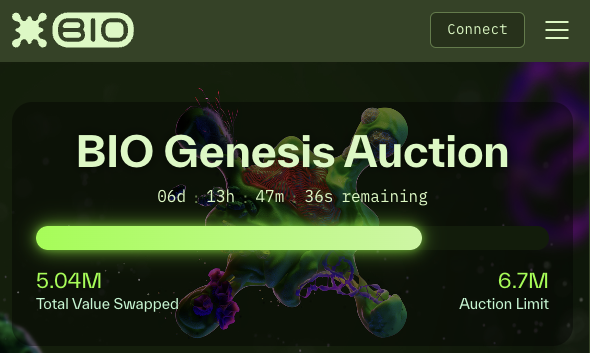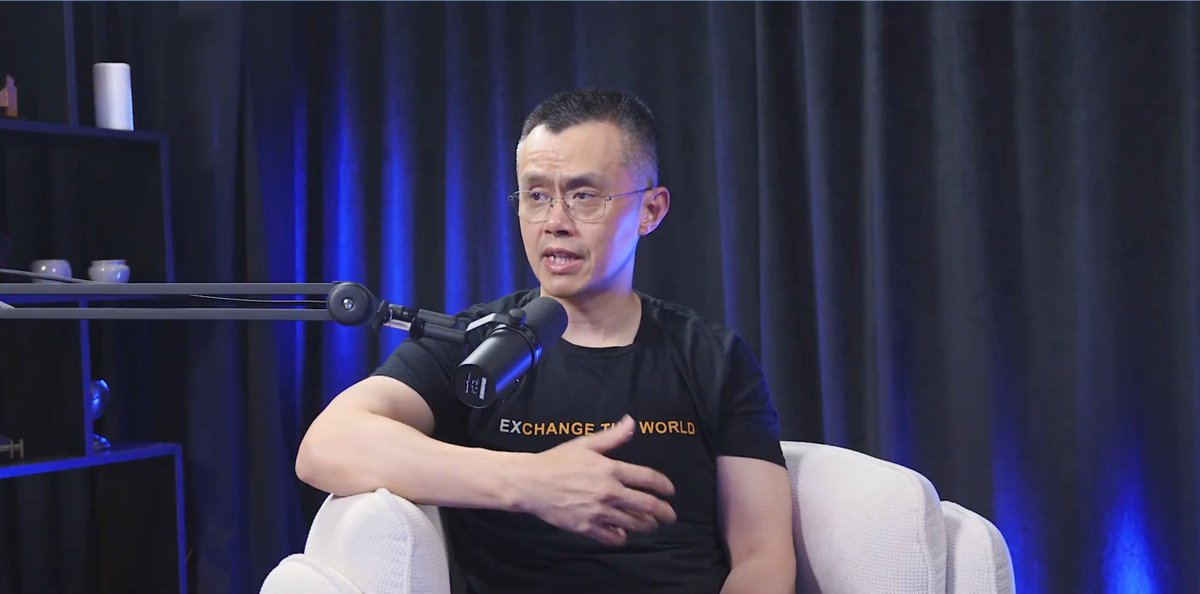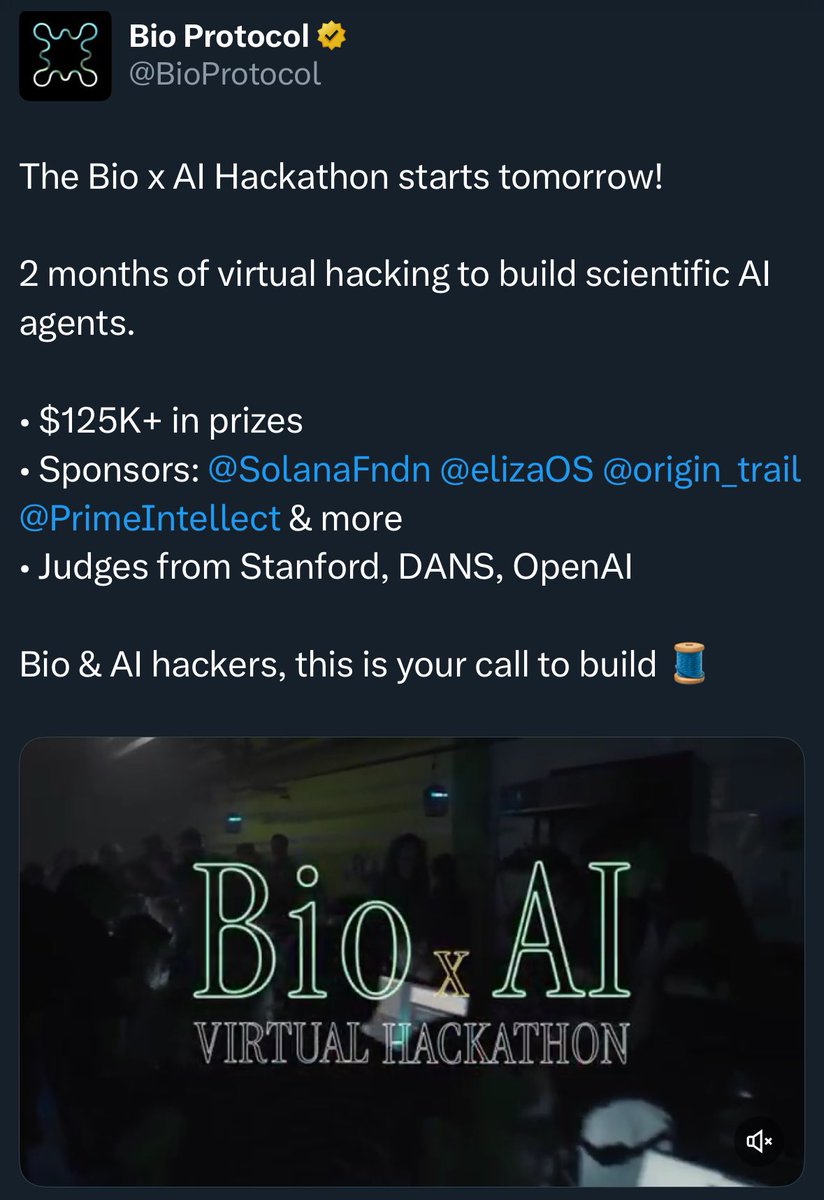
BIO
BIO 价格
$0.088000
+$0.0031800
(+3.74%)
过去 24 小时的价格变化

您感觉 BIO 今天会涨还是会跌?
您可以通过点赞或点踩来分享对该币种今天的涨跌预测
投票并查看结果
免责声明
本页面的社交内容 (包括由 LunarCrush 提供支持的推文和社交统计数据) 均来自第三方,并按“原样”提供,仅供参考。本文内容不代表对任何数字货币或投资的认可或推荐,也未获得欧易授权或撰写,也不代表我们的观点。我们不保证所显示的用户生成内容的准确性或可靠性。本文不应被解释为财务或投资建议。在做出投资决策之前,评估您的投资经验、财务状况、投资目标和风险承受能力并咨询独立财务顾问至关重要。过去的表现并不代表未来的结果。您的投资价值可能会波动,您可能无法收回您投资的金额。您对自己的投资选择自行承担全部责任,我们对因使用本信息而造成的任何损失或损害不承担任何责任。提供外部网站链接是为了用户方便,并不意味着对其内容的认可或控制。
请参阅我们的 使用条款 和 风险警告,了解更多详情。通过使用第三方网站(“第三方网站”),您同意对第三方网站的任何使用均受第三方网站条款的约束和管辖。除非书面明确说明,否则欧易及其关联方(“OKX”)与第三方网站的所有者或运营商没有任何关联。您同意欧易对您使用第三方网站而产生的任何损失、损害和任何其他后果不承担任何责任。请注意,使用第三方网站可能会导致您的资产损失或贬值。本产品可能无法在所有司法管辖区提供或适用。
请参阅我们的 使用条款 和 风险警告,了解更多详情。通过使用第三方网站(“第三方网站”),您同意对第三方网站的任何使用均受第三方网站条款的约束和管辖。除非书面明确说明,否则欧易及其关联方(“OKX”)与第三方网站的所有者或运营商没有任何关联。您同意欧易对您使用第三方网站而产生的任何损失、损害和任何其他后果不承担任何责任。请注意,使用第三方网站可能会导致您的资产损失或贬值。本产品可能无法在所有司法管辖区提供或适用。
BIO 市场信息
市值
市值是通过流通总应量与最新价格相乘进行计算。市值 = 当前流通量 × 最新价
流通总量
目前该代币在市场流通的数量
市值排行
该资产的市值排名
历史最高价
该代币在交易历史中的最高价格
历史最低价
该代币在交易历史中的最低价格
24 小时最高
$0.094400
24 小时最低
$0.082690
历史最高价
$0.90750
-90.31% (-$0.81950)
最后更新日期:2025年1月3日
历史最低价
$0.040470
+117.44% (+$0.047530)
最后更新日期:2025年4月17日
BIO 动态资讯
以下内容源自 。

ariel seidman 已转发

Anchorage Digital ⚓ 🔜 Consensus
Anchorage Digital最近增加了对18种新资产的支持:
+ @Aptos: Aptos上的USDC (USDC)
+ @Arbitrum: Arbitrum上的@animecoin (ANIME)
+ @Base: @navigate_ai (NVG8)
+ @Ethereum: @BioProtocol (BIO), @letsdivvi (DIVVI), @HashKeyGroup (HSK), @Hyperlane (HYPER), Mystiko Token (XZK), @pendle_fi (PENDLE), Perion Credits (PERC), 以及Base上的@recallnet (RECALL)
+ @solana: Solana上的@Hivemapper (HONEY), @NATIXNetwork (NATIX), Solana上的@Parcl (PARCL), 以及Solana上的@UpRockCom (UPT)
+ @StellarOrg: Stellar (XLM)
+ @SuiNetwork: Sui上的@suilendprotocol (SEND) 和Sui上的@WalrusProtocol (WAL)
查看原文15.52万
56

Roger波杰克
. $BIO |位于 DeSci + AI 交汇点的加速引擎
在过去的一周里,尽管市场震荡, $BIO 的价格却逆势走强,成交量不断放大——这充分说明:在市场回暖时,那些具备扎实基本面的项目更具爆发潜力。
不过,如果你只看到了短期涨幅,那就低估了Bio Protocol正在构建的深层价值。
$BIO 不是一个简单的代币项目,而是正在推进三项根本性变革:
* 🌐 一个去中心化、模块化、跨链运行的科研金融系统
* 🧠 一个由 AI 驱动、数据自生长的生物科技智能网络
* 💡 一个开放可参与的科研资助平台,让每个人都能加速医学创新
---
🔬 DeSci x AI:在 Bio Protocol 上全面融合
最近,Bio 正式推出了 BioAgents 模块,这是专为 BioDAO 生态设计的链上科研智能体。
什么是 BioAgents?
它是一个由数据驱动的 AI 工具,具备以下能力:
* 自动执行科研任务,如实验设计、假设生成与数据分析
* 实时学习 BioDAO 生态中的 R&D 数据
* 构建链上的 知识图谱(Knowledge Graph)
并且,BioAgents 不只是用于内部科研,还能授权给第三方药企和研究机构使用,带来真实收入。这些收入将部分用于回购并销毁 $BIO,形成通缩闭环机制。
🔥 首个 BioAgents 插件由 Bio 与 elizaOS 合作推出,能够自动将科学论文与生物数据转化为研究假设!
详情请见:BioAgents 插件上线公告(
⚡ 同时,Bio 正在举办一场史无前例的 Agentic Science Hackathon,奖金池超 125,000 美元,由 Solana、elizaOS、OriginTrail 等项目联合赞助。
活动详情:Hackathon 页面(
Bio 正在用行动推进 AI 与生物科技的融合,让科研从依赖人力的高成本流程,转向开放自治的智能系统。
---
💥 Staking 机制即将上线,开启价值捕获新阶段
Bio 同时在积极推进 $BIO 的质押系统。
📌 最新社区治理提案中指出:
* 用户可质押 $BIO,参与 BioDAO 的筛选与治理流程
* 获得新成立 BioDAO 的 Token 分配与 IP-Token 收益
* 未来可能分享 BioAgents 的服务费用
换句话说,持有 $BIO 不再只是买币,而是成为整个 Bio 生态网络的“股东”,持续享受 DeSci 赛道的增长红利。
📑 详细内容见:BIO Staking 治理提案(
在 DeFi 之外,Bio 正在开辟一个全新领域 —— 科研质押金融(Staking-as-Science)。
---
🚀 BioDAO 生态扩张持续进行中:SpineDAO & MycoDAO 已启动
BioDAO 子生态不断壮大,最近上线的两个子项目包括:
* SpineDAO:聚焦脊柱健康与治疗研发
- FILTER Agent::AI 分诊工具,优先处理脊柱护理案例,使用区块链和代币激励优化治疗路径
- DeScide:脊柱外科医生的AI决策工具,使用预测模型标准化治疗并减少并发症
- TraCker:基于人工智能和物联网的术后监测系统,通过区块链安全数据早期检测并发症
- Spine Archive:AI驱动的平台,将脊柱健康研究数字化,实现智能发现和临床洞察
* MycoDAO:围绕真菌研究与新型疗法展开
- 研究平台:用于分析真菌数据的人工智能工具,可能使用区块链和代币来激励研究贡献
- 社区工具:用于真菌物种鉴定或环境分析的AI模型,支持分散的菌类学研究。
这两个 DAO 都已开放 $BIO 持有者参与质押锁仓,享有早期 Token 分配权,并通常伴随显著折扣。
💡这不仅是投资早期科研项目的机会,更是成为尚未商业化的科研 IP 的早期持有者的稀缺通道。
📎 启动详情见:SpineDAO 和 MycoDAO 公告(
未来随着更多 BioDAO 启动,质押者的收益渠道将不断扩展,形成正向生态循环。
---
🏆 总结:Bio Protocol 正在打造科研领域的“以太坊”
Bio 的目标远不止发币平台,而是:
* 🔗 构建科研资产自由流通的底层网络
* 🤖 通过 BioAgents 接入 AI,让科研过程自演化、链上运行
* 📈 借助 Staking 机制,让参与者真正捕获 DeSci 赛道的长期收益
放眼整个加密世界,能如此深入融合 DeSci 与 AI,且已有实际落地成果的,Bio Protocol 是少数中的佼佼者。
随着 Bio V1 正式上线、BioAgents 推出、Staking 与 BioDAO 生态齐头并进,Bio 很可能成为下一轮 DeSci Narrative 爆发中的核心资产。
---
🧬 想了解更多?关注官方频道获取一手动态:
* X
* Discord
* Telegram
DeSci 的未来已经在提速, $BIO 或许就是你进入这场革命的最好船票。

2.41万
41

zac.eth 🧙🏻♂️♦️
还有6天可以参与@bioprotocol的$BIO代币创世(我已参与)
👉
$BIO正在创建一个新的加密类别——“科学金融”或SciFi——DeFi和DeSci的共生
该协议旨在对齐激励措施并增加生物DAO的资本,加深SciFi的流动性并加速链上科学的进程。🧑🔬🧪
可兑换$BIO的合格代币:
• $VITA - @vita_dao
• $NEURON - @Cerebrum_DAO
• $HAIR - @HairDAO_
• $GROW - @valley_dao
• $ATH - @athena_DAO_
• $CRYO - @cryodao
• $RSC - @ResearchHub
• $PSY - @psy_dao
📜 了解更多:
🔗 Alpha:
查看原文
5万
69
BIO 计算器


BIO 价格表现 (美元)
BIO 当前价格为 $0.088000。BIO 的价格在过去 24 小时内上涨了 +3.75%。目前,BIO 市值排名为第 0 名,实时市值为 $1.48亿,流通供应量为 1,670,632,971 BIO,最大供应量为 3,320,000,000 BIO。我们会实时更新 BIO/USD 的价格。
今日
+$0.0031800
+3.74%
7 天
+$0.027810
+46.20%
30 天
+$0.030480
+52.99%
3 个月
-$0.05150
-36.92%
关于 BIO (BIO)
此评级是欧易从不同来源收集的汇总评级,仅供一般参考。欧易不保证评级的质量或准确性。欧易无意提供 (i) 投资建议或推荐;(ii) 购买、出售或持有数字资产的要约或招揽;(iii) 财务、会计、法律或税务建议。包括稳定币和 NFT 的数字资产容易受到市场波动的影响,风险较高,波动较大,可能会贬值甚至变得一文不值。数字资产的价格和性能不受保证,且可能会发生变化,恕不另行通知。您的数字资产不受潜在损失保险的保障。 历史回报并不代表未来回报。欧易不保证任何回报、本金或利息的偿还。欧易不提供投资或资产建议。您应该根据自身的财务状况仔细考虑交易或持有数字资产是否适合您。具体情况请咨询您的专业法务、税务或投资人士。
展开更多
- 官网
- 白皮书
- 区块浏览器
关于第三方网站
关于第三方网站
通过使用第三方网站(“第三方网站”),您同意对第三方网站的任何使用均受第三方网站条款的约束和管辖。除非书面明确说明,否则 OKX 及其关联方(“OKX”)与第三方网站的所有者或运营商没有任何关联。您同意 OKX 对您使用第三方网站而产生的任何损失、损害和任何其他后果不承担任何责任。请注意,使用第三方网站可能会导致您的资产损失或贬值。
BIO 常见问题
BIO 今天值多少钱?
目前,一个 BIO 价值是 $0.088000。如果您想要了解 BIO 价格走势与行情洞察,那么这里就是您的最佳选择。在欧易探索最新的 BIO 图表,进行专业交易。
数字货币是什么?
数字货币,例如 BIO 是在称为区块链的公共分类账上运行的数字资产。了解有关欧易上提供的数字货币和代币及其不同属性的更多信息,其中包括实时价格和实时图表。
数字货币是什么时候开始的?
由于 2008 年金融危机,人们对去中心化金融的兴趣激增。比特币作为去中心化网络上的安全数字资产提供了一种新颖的解决方案。从那时起,许多其他代币 (例如 BIO) 也诞生了。
BIO 的价格今天会涨吗?
查看 BIO 价格预测页面,预测未来价格,帮助您设定价格目标。
ESG 披露
ESG (环境、社会和治理) 法规针对数字资产,旨在应对其环境影响 (如高能耗挖矿)、提升透明度,并确保合规的治理实践。使数字代币行业与更广泛的可持续发展和社会目标保持一致。这些法规鼓励遵循相关标准,以降低风险并提高数字资产的可信度。
资产详情
名称
OKcoin Europe LTD
相关法人机构识别编码
54930069NLWEIGLHXU42
代币名称
bio_protocol
共识机制
bio_protocol is present on the following networks: ethereum, solana.
The Ethereum network uses a Proof-of-Stake Consensus Mechanism to validate new transactions on the blockchain. Core Components 1. Validators: Validators are responsible for proposing and validating new blocks. To become a validator, a user must deposit (stake) 32 ETH into a smart contract. This stake acts as collateral and can be slashed if the validator behaves dishonestly. 2. Beacon Chain: The Beacon Chain is the backbone of Ethereum 2.0. It coordinates the network of validators and manages the consensus protocol. It is responsible for creating new blocks, organizing validators into committees, and implementing the finality of blocks. Consensus Process 1. Block Proposal: Validators are chosen randomly to propose new blocks. This selection is based on a weighted random function (WRF), where the weight is determined by the amount of ETH staked. 2. Attestation: Validators not proposing a block participate in attestation. They attest to the validity of the proposed block by voting for it. Attestations are then aggregated to form a single proof of the block’s validity. 3. Committees: Validators are organized into committees to streamline the validation process. Each committee is responsible for validating blocks within a specific shard or the Beacon Chain itself. This ensures decentralization and security, as a smaller group of validators can quickly reach consensus. 4. Finality: Ethereum 2.0 uses a mechanism called Casper FFG (Friendly Finality Gadget) to achieve finality. Finality means that a block and its transactions are considered irreversible and confirmed. Validators vote on the finality of blocks, and once a supermajority is reached, the block is finalized. 5. Incentives and Penalties: Validators earn rewards for participating in the network, including proposing blocks and attesting to their validity. Conversely, validators can be penalized (slashed) for malicious behavior, such as double-signing or being offline for extended periods. This ensures honest participation and network security.
Solana uses a unique combination of Proof of History (PoH) and Proof of Stake (PoS) to achieve high throughput, low latency, and robust security. Here’s a detailed explanation of how these mechanisms work: Core Concepts 1. Proof of History (PoH): Time-Stamped Transactions: PoH is a cryptographic technique that timestamps transactions, creating a historical record that proves that an event has occurred at a specific moment in time. Verifiable Delay Function: PoH uses a Verifiable Delay Function (VDF) to generate a unique hash that includes the transaction and the time it was processed. This sequence of hashes provides a verifiable order of events, enabling the network to efficiently agree on the sequence of transactions. 2. Proof of Stake (PoS): Validator Selection: Validators are chosen to produce new blocks based on the number of SOL tokens they have staked. The more tokens staked, the higher the chance of being selected to validate transactions and produce new blocks. Delegation: Token holders can delegate their SOL tokens to validators, earning rewards proportional to their stake while enhancing the network's security. Consensus Process 1. Transaction Validation: Transactions are broadcast to the network and collected by validators. Each transaction is validated to ensure it meets the network’s criteria, such as having correct signatures and sufficient funds. 2. PoH Sequence Generation: A validator generates a sequence of hashes using PoH, each containing a timestamp and the previous hash. This process creates a historical record of transactions, establishing a cryptographic clock for the network. 3. Block Production: The network uses PoS to select a leader validator based on their stake. The leader is responsible for bundling the validated transactions into a block. The leader validator uses the PoH sequence to order transactions within the block, ensuring that all transactions are processed in the correct order. 4. Consensus and Finalization: Other validators verify the block produced by the leader validator. They check the correctness of the PoH sequence and validate the transactions within the block. Once the block is verified, it is added to the blockchain. Validators sign off on the block, and it is considered finalized. Security and Economic Incentives 1. Incentives for Validators: Block Rewards: Validators earn rewards for producing and validating blocks. These rewards are distributed in SOL tokens and are proportional to the validator’s stake and performance. Transaction Fees: Validators also earn transaction fees from the transactions included in the blocks they produce. These fees provide an additional incentive for validators to process transactions efficiently. 2. Security: Staking: Validators must stake SOL tokens to participate in the consensus process. This staking acts as collateral, incentivizing validators to act honestly. If a validator behaves maliciously or fails to perform, they risk losing their staked tokens. Delegated Staking: Token holders can delegate their SOL tokens to validators, enhancing network security and decentralization. Delegators share in the rewards and are incentivized to choose reliable validators. 3. Economic Penalties: Slashing: Validators can be penalized for malicious behavior, such as double-signing or producing invalid blocks. This penalty, known as slashing, results in the loss of a portion of the staked tokens, discouraging dishonest actions.
奖励机制与相应费用
bio_protocol is present on the following networks: ethereum, solana.
Ethereum, particularly after transitioning to Ethereum 2.0 (Eth2), employs a Proof-of-Stake (PoS) consensus mechanism to secure its network. The incentives for validators and the fee structures play crucial roles in maintaining the security and efficiency of the blockchain. Incentive Mechanisms 1. Staking Rewards: Validator Rewards: Validators are essential to the PoS mechanism. They are responsible for proposing and validating new blocks. To participate, they must stake a minimum of 32 ETH. In return, they earn rewards for their contributions, which are paid out in ETH. These rewards are a combination of newly minted ETH and transaction fees from the blocks they validate. Reward Rate: The reward rate for validators is dynamic and depends on the total amount of ETH staked in the network. The more ETH staked, the lower the individual reward rate, and vice versa. This is designed to balance the network's security and the incentive to participate. 2. Transaction Fees: Base Fee: After the implementation of Ethereum Improvement Proposal (EIP) 1559, the transaction fee model changed to include a base fee that is burned (i.e., removed from circulation). This base fee adjusts dynamically based on network demand, aiming to stabilize transaction fees and reduce volatility. Priority Fee (Tip): Users can also include a priority fee (tip) to incentivize validators to include their transactions more quickly. This fee goes directly to the validators, providing them with an additional incentive to process transactions efficiently. 3. Penalties for Malicious Behavior: Slashing: Validators face penalties (slashing) if they engage in malicious behavior, such as double-signing or validating incorrect information. Slashing results in the loss of a portion of their staked ETH, discouraging bad actors and ensuring that validators act in the network's best interest. Inactivity Penalties: Validators also face penalties for prolonged inactivity. This ensures that validators remain active and engaged in maintaining the network's security and operation. Fees Applicable on the Ethereum Blockchain 1. Gas Fees: Calculation: Gas fees are calculated based on the computational complexity of transactions and smart contract executions. Each operation on the Ethereum Virtual Machine (EVM) has an associated gas cost. Dynamic Adjustment: The base fee introduced by EIP-1559 dynamically adjusts according to network congestion. When demand for block space is high, the base fee increases, and when demand is low, it decreases. 2. Smart Contract Fees: Deployment and Interaction: Deploying a smart contract on Ethereum involves paying gas fees proportional to the contract's complexity and size. Interacting with deployed smart contracts (e.g., executing functions, transferring tokens) also incurs gas fees. Optimizations: Developers are incentivized to optimize their smart contracts to minimize gas usage, making transactions more cost-effective for users. 3. Asset Transfer Fees: Token Transfers: Transferring ERC-20 or other token standards involves gas fees. These fees vary based on the token's contract implementation and the current network demand.
Solana uses a combination of Proof of History (PoH) and Proof of Stake (PoS) to secure its network and validate transactions. Here’s a detailed explanation of the incentive mechanisms and applicable fees: Incentive Mechanisms 4. Validators: Staking Rewards: Validators are chosen based on the number of SOL tokens they have staked. They earn rewards for producing and validating blocks, which are distributed in SOL. The more tokens staked, the higher the chances of being selected to validate transactions and produce new blocks. Transaction Fees: Validators earn a portion of the transaction fees paid by users for the transactions they include in the blocks. This provides an additional financial incentive for validators to process transactions efficiently and maintain the network's integrity. 5. Delegators: Delegated Staking: Token holders who do not wish to run a validator node can delegate their SOL tokens to a validator. In return, delegators share in the rewards earned by the validators. This encourages widespread participation in securing the network and ensures decentralization. 6. Economic Security: Slashing: Validators can be penalized for malicious behavior, such as producing invalid blocks or being frequently offline. This penalty, known as slashing, involves the loss of a portion of their staked tokens. Slashing deters dishonest actions and ensures that validators act in the best interest of the network. Opportunity Cost: By staking SOL tokens, validators and delegators lock up their tokens, which could otherwise be used or sold. This opportunity cost incentivizes participants to act honestly to earn rewards and avoid penalties. Fees Applicable on the Solana Blockchain 7. Transaction Fees: Low and Predictable Fees: Solana is designed to handle a high throughput of transactions, which helps keep fees low and predictable. The average transaction fee on Solana is significantly lower compared to other blockchains like Ethereum. Fee Structure: Fees are paid in SOL and are used to compensate validators for the resources they expend to process transactions. This includes computational power and network bandwidth. 8. Rent Fees: State Storage: Solana charges rent fees for storing data on the blockchain. These fees are designed to discourage inefficient use of state storage and encourage developers to clean up unused state. Rent fees help maintain the efficiency and performance of the network. 9. Smart Contract Fees: Execution Costs: Similar to transaction fees, fees for deploying and interacting with smart contracts on Solana are based on the computational resources required. This ensures that users are charged proportionally for the resources they consume.
信息披露时间段的开始日期
2024-04-20
信息披露时间段的结束日期
2025-04-20
能源报告
能源消耗
1246.55846 (kWh/a)
能源消耗来源与评估体系
The energy consumption of this asset is aggregated across multiple components:
To determine the energy consumption of a token, the energy consumption of the network(s) ethereum, solana is calculated first. Based on the crypto asset's gas consumption per network, the share of the total consumption of the respective network that is assigned to this asset is defined. When calculating the energy consumption, we used - if available - the Functionally Fungible Group Digital Token Identifier (FFG DTI) to determine all implementations of the asset of question in scope and we update the mappings regulary, based on data of the Digital Token Identifier Foundation.
BIO 计算器



















